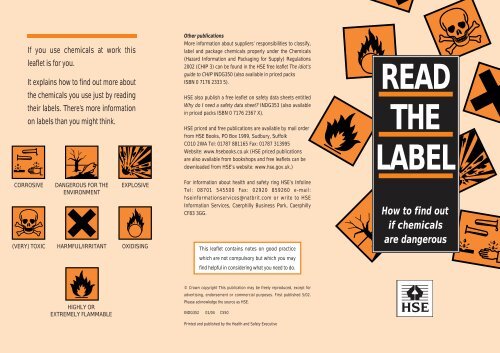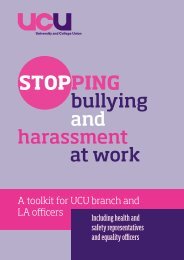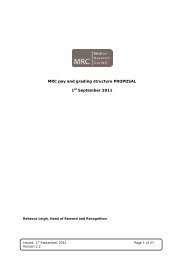INDG352 - Read the label - how to find out if chemicals are ... - UCU
INDG352 - Read the label - how to find out if chemicals are ... - UCU
INDG352 - Read the label - how to find out if chemicals are ... - UCU
You also want an ePaper? Increase the reach of your titles
YUMPU automatically turns print PDFs into web optimized ePapers that Google loves.
If you use <strong>chemicals</strong> at work this<br />
leaflet is for you.<br />
It explains <strong>how</strong> <strong>to</strong> <strong>find</strong> <strong>out</strong> more ab<strong>out</strong><br />
<strong>the</strong> <strong>chemicals</strong> you use just by reading<br />
<strong>the</strong>ir <strong>label</strong>s. There’s more information<br />
on <strong>label</strong>s than you might think.<br />
O<strong>the</strong>r publications<br />
More information ab<strong>out</strong> suppliers’ responsibilities <strong>to</strong> class<strong>if</strong>y,<br />
<strong>label</strong> and package <strong>chemicals</strong> properly under <strong>the</strong> Chemicals<br />
(Hazard Information and Packaging for Supply) Regulations<br />
2002 (CHIP 3) can be found in <strong>the</strong> HSE free leaflet The idiot’s<br />
guide <strong>to</strong> CHIP INDG350 (also available in priced packs<br />
ISBN 0 7176 2333 5).<br />
HSE also publish a free leaflet on safety data sheets entitled<br />
Why do I need a safety data sheet INDG353 (also available<br />
in priced packs ISBN 0 7176 2367 X).<br />
HSE priced and free publications <strong>are</strong> available by mail order<br />
from HSE Books, PO Box 1999, Sudbury, Suffolk<br />
CO10 2WA Tel: 01787 881165 Fax: 01787 313995<br />
Website: www.hsebooks.co.uk (HSE priced publications<br />
<strong>are</strong> also available from bookshops and free leaflets can be<br />
downloaded from HSE’s website: www.hse.gov.uk.)<br />
READ<br />
THE<br />
LABEL<br />
CORROSIVE<br />
(VERY) TOXIC<br />
DANGEROUS FOR THE<br />
ENVIRONMENT<br />
HARMFUL/IRRITANT<br />
EXPLOSIVE<br />
OXIDISING<br />
For information ab<strong>out</strong> health and safety ring HSE’s Infoline<br />
Tel: 08701 545500 Fax: 02920 859260 e-mail:<br />
hseinformationservices@natbrit.com or write <strong>to</strong> HSE<br />
Information Services, Caerphilly Business Park, Caerphilly<br />
CF83 3GG.<br />
This leaflet contains notes on good practice<br />
How <strong>to</strong> <strong>find</strong> <strong>out</strong><br />
<strong>if</strong> <strong>chemicals</strong><br />
<strong>are</strong> dangerous<br />
which <strong>are</strong> not compulsory but which you may<br />
<strong>find</strong> helpful in considering what you need <strong>to</strong> do.<br />
© Crown copyright This publication may be freely reproduced, except for<br />
advertising, endorsement or commercial purposes. First published 5/02.<br />
HIGHLY OR<br />
EXTREMELY FLAMMABLE<br />
Please acknowledge <strong>the</strong> source as HSE.<br />
<strong>INDG352</strong> 01/04 C550<br />
Printed and published by <strong>the</strong> Health and Safety Executive
CHEMICALS A chemical is not just something<br />
used by scientists in labora<strong>to</strong>ries. Most people use<br />
<strong>chemicals</strong> as part of <strong>the</strong>ir job or at home every day.<br />
Cleaning products such as bleach and oven sprays <strong>are</strong><br />
<strong>chemicals</strong>. So <strong>are</strong> paints, inks, glues, and oils.<br />
Most of <strong>the</strong> <strong>chemicals</strong> you might use at work <strong>are</strong> not<br />
dangerous <strong>if</strong> you use <strong>the</strong>m properly and know what <strong>to</strong> do<br />
<strong>if</strong> something goes wrong (such as spillage). But some<br />
<strong>chemicals</strong> need more c<strong>are</strong>ful handling than o<strong>the</strong>rs.<br />
Labels can help you ident<strong>if</strong>y <strong>the</strong> more hazardous<br />
<strong>chemicals</strong>, tell you what <strong>the</strong> dangers <strong>are</strong>, and <strong>how</strong> <strong>to</strong><br />
avoid <strong>the</strong>m.<br />
SO WHAT CAN A LABEL TELL ME A <strong>label</strong> can<br />
tell you a lot. Let’s take a look at a typical <strong>label</strong> (below)<br />
you might <strong>find</strong> on a chemical used in <strong>the</strong> workplace. You<br />
will see that it gives basic information which alerts you<br />
<strong>to</strong> <strong>the</strong> dangers and precautions, and gives details ab<strong>out</strong><br />
<strong>the</strong> supplier so you can get fu<strong>the</strong>r advice. Look for <strong>the</strong><br />
<strong>label</strong> on all <strong>the</strong> <strong>chemicals</strong> you use.<br />
HAZARD SYMBOL<br />
These <strong>are</strong> always black on orange .<br />
They alert you <strong>to</strong> <strong>the</strong> main dangers<br />
posed by <strong>the</strong> chemical. O<strong>the</strong>r<br />
symbols you might expect <strong>to</strong> see <strong>are</strong><br />
illustrated overleaf. Not all <strong>label</strong>s will<br />
have symbols, but all will contain <strong>the</strong><br />
brief list of warnings and safety<br />
advice<br />
INDICATION OF DANGER<br />
This gives <strong>the</strong> meaning of <strong>the</strong> symbol<br />
Toxic<br />
EC <strong>label</strong> 203-856-5<br />
Dangerous<br />
for <strong>the</strong><br />
environment<br />
Glutaraldehyde<br />
WHAT USE IS THIS INFORMATION As well as helping<br />
users <strong>the</strong> information on <strong>the</strong> <strong>label</strong> helps employers ident<strong>if</strong>y<br />
dangerous <strong>chemicals</strong> and undertake risk assessments under <strong>the</strong><br />
Control of Substances Hazardous <strong>to</strong> Health Regulations<br />
(COSHH). By law, suppliers of <strong>chemicals</strong> <strong>are</strong> required <strong>to</strong> <strong>label</strong><br />
<strong>the</strong>ir products with hazard symbols, warnings and safety advice<br />
<strong>if</strong> a chemical is dangerous; managers in workplaces where<br />
<strong>chemicals</strong> <strong>are</strong> kept or used must ensure that <strong>the</strong> <strong>chemicals</strong> <strong>are</strong><br />
used safely. For more information see <strong>the</strong> leaflet COSHH: a brief<br />
guide <strong>to</strong> <strong>the</strong> Regulations INDG136 (rev 2) (single copies available<br />
free, also available in priced packs ISBN 0 7176 2677 6).<br />
FURTHER SAFETY INSTRUCTIONS Manufacturers<br />
may also include ‘instructions for use’ ei<strong>the</strong>r on <strong>the</strong> <strong>label</strong>, or<br />
on a leaflet supplied with <strong>the</strong> product. Suppliers must provide<br />
safety data sheets for dangerous <strong>chemicals</strong> used in <strong>the</strong><br />
workplace. This is a detailed information sheet provided by<br />
chemical suppliers <strong>to</strong> <strong>the</strong>ir cus<strong>to</strong>mers so that workers and <strong>the</strong><br />
environment can be properly protected. It is not confidential<br />
and employees and <strong>the</strong>ir representatives should be provided<br />
with copies on request. If a safety data sheet isn’t provided<br />
Toxic by inhalation and <strong>if</strong> swallowed<br />
Causes burns<br />
May cause sensitisation by inhalation and by skin<br />
contact<br />
Very <strong>to</strong>xic <strong>to</strong> aquatic organisms<br />
Keep locked up and <strong>out</strong> of <strong>the</strong> reach of children<br />
In case of contact with eyes, rinse immediately with<br />
plenty of water and seek medical advice<br />
Wear suitable protective clothing, gloves and eye/face<br />
protection<br />
In case of accident or <strong>if</strong> you feel unwell seek medical<br />
advice immediately (s<strong>how</strong> <strong>the</strong> <strong>label</strong> where possible)<br />
Avoid release <strong>to</strong> <strong>the</strong> environment. Refer <strong>to</strong> special<br />
instructions/safety data sheet<br />
Supplied by:<br />
Name, address and telephone number of supplier<br />
WARNINGS AND<br />
SAFETY ADVICE<br />
The <strong>label</strong> also contains a brief list of<br />
warnings and safety advice. The law<br />
requires suppliers of <strong>chemicals</strong> <strong>to</strong><br />
tell you what hazards a chemical<br />
might pose and <strong>how</strong> <strong>to</strong> use it safely.<br />
The information is brief but important.<br />
If it advises you <strong>to</strong> avoid contact<br />
with skin <strong>the</strong>n you should do just<br />
that. The advice is on <strong>the</strong> <strong>label</strong> for<br />
your safety.<br />
with <strong>the</strong> chemical, your employer should ask <strong>the</strong> supplier<br />
<strong>to</strong> provide one. Someone in your company should<br />
receive a safety data sheet for each of <strong>the</strong> dangerous<br />
<strong>chemicals</strong> <strong>the</strong> company uses. Safety data sheets provide<br />
more technical and detailed information ab<strong>out</strong> <strong>the</strong> chemical<br />
and more information ab<strong>out</strong> <strong>how</strong> <strong>to</strong> use it safely and<br />
<strong>how</strong> <strong>to</strong> deal with emergencies.<br />
I WANT TO KNOW MORE If you work with<br />
dangerous <strong>chemicals</strong> and you want more information, you<br />
should ask ab<strong>out</strong> your employer’s risk assessment and its<br />
conclusions ab<strong>out</strong> <strong>the</strong> risks in your workplace and what<br />
precautions should be taken. Or, <strong>if</strong> you need <strong>to</strong> know more<br />
ab<strong>out</strong> a particular dangerous chemical, you could ask for<br />
<strong>the</strong> safety data sheet. Safety data sheets can be used by<br />
your employer <strong>to</strong> do a COSHH Essentials risk assessment<br />
which advises your employer on <strong>the</strong> right way <strong>to</strong> protect<br />
your health from hazardous substances. Your employer<br />
can do a free COSHH Essentials risk assessment through<br />
<strong>the</strong> Internet ei<strong>the</strong>r via www.hsedirect.com or directly on<br />
www.coshh-essentials.org.uk.<br />
Fur<strong>the</strong>r information on <strong>the</strong> law on <strong>label</strong>ling and<br />
chemical hazard class<strong>if</strong>ication is also available on <strong>the</strong><br />
Health and Safety Executive’s (HSE’s) CHIP website:<br />
www.hse.gov.uk/chip/index.htm.<br />
Safety representatives<br />
If you have any questions ab<strong>out</strong> safety precautions for<br />
dangerous <strong>chemicals</strong>, ask your employer first. If <strong>the</strong>re<br />
is a safety representative or representative of employee<br />
safety in your workplace you may <strong>find</strong> it useful <strong>to</strong> talk<br />
over any concerns that you still have.<br />
Most people think that accidents only ever happen <strong>to</strong><br />
somebody else. Until <strong>the</strong>y happen <strong>to</strong> you. For your own<br />
safety and <strong>the</strong> safety of those you work with, each time<br />
you use a chemical, pause for a moment and<br />
READ THE LABEL.






![(.pdf) [29kb] - UCU](https://img.yumpu.com/50914942/1/184x260/pdf-29kb-ucu.jpg?quality=85)









